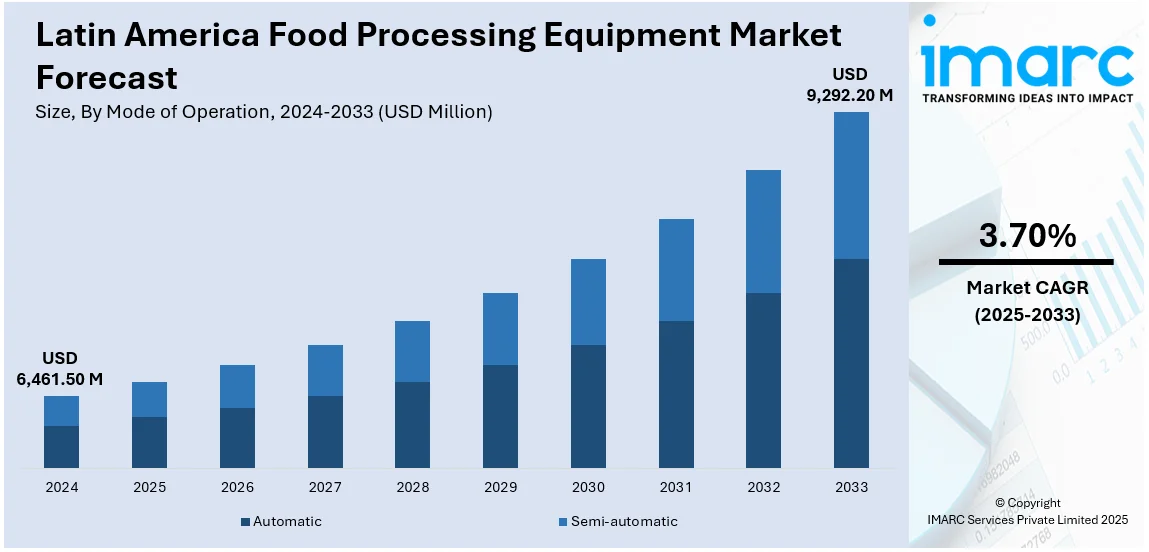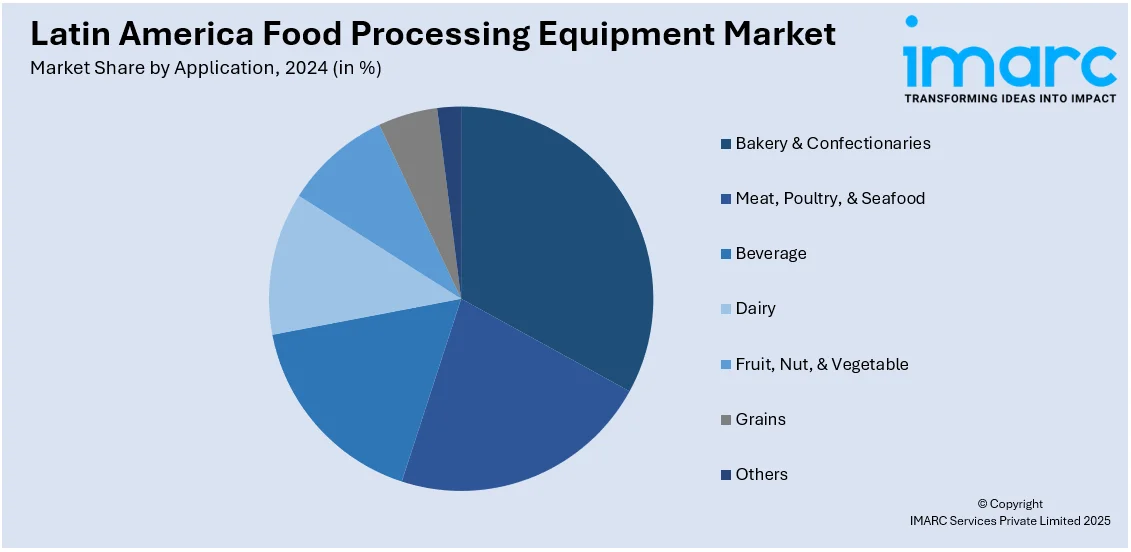
Latin America Food Processing Equipment Market Size, Share, Trends and Forecast by Mode of Operation, Application, Type, and Region, 2025-2033
Latin America Food Processing Equipment Market Overview:
The Latin America food processing equipment market size reached USD 6,461.50 Million in 2024. Looking forward, IMARC Group expects the market to reach USD 9,292.20 Million by 2033, exhibiting a growth rate (CAGR) of 3.70% during 2025-2033. The Latin America food processing equipment market share is primarily driven by the growing processed food sector, increasing investments in infrastructure and technological advancements, and government initiatives supporting food production modernization.
|
Report Attribute
|
Key Statistics
|
|---|---|
|
Base Year
|
2024 |
|
Forecast Years
|
2025-2033
|
|
Historical Years
|
2019-2024
|
| Market Size in 2024 | USD 6,461.50 Million |
| Market Forecast in 2033 | USD 9,292.20 Million |
| Market Growth Rate 2025-2033 | 3.70% |
Latin America Food Processing Equipment Market Trends:
Expansion of Export-Oriented Food Production
The expansion of export-oriented food production is significantly influencing the Latin America food processing equipment market outlook. Countries are increasing food exports to meet rising global demand for processed and high-quality agricultural products. Manufacturers are investing in advanced processing equipment to ensure efficiency, consistency, and compliance with international food safety regulations. Governments are supporting export-driven growth by implementing trade policies, incentives, and infrastructure development programs for food processing. Tax benefits and subsidies are encouraging companies to upgrade facilities with automated and energy-efficient processing machinery. Stricter import regulations in key markets are pushing producers to adopt high-quality equipment meeting global hygiene and quality standards. Technological advancements like IoT-enabled processing systems and robotics are improving food production efficiency and traceability. The growing demand for processed meat, dairy, and plant-based products is catalyzing investments in specialized processing equipment. As Latin America strengthens its position in global food exports, equipment demand continues rising. This trend is positioning the region as a key market for cutting-edge food processing technologies. Businesses are striving to enhance production capacity, maintain product quality, and meet international consumer expectations. The increasing focus on sustainability and food safety is further fueling equipment adoption.

Government Investments in Agricultural and Food Processing
Government investments in agricultural modernization and food processing infrastructure are significantly propelling the Latin America food processing equipment market growth. Countries like Argentina and Mexico are implementing strategic initiatives to enhance food processing capabilities, with governing agencies offering policies and subsidies to boost private sector participation. Tax incentives and grants encourage companies to upgrade facilities and adopt advanced technologies, escalating demand for modern equipment. Additionally, programs aimed at improving food export capabilities such as Argentina’s encouragement to expand agricultural exports, are prompting food manufacturers to invest in equipment that meets global quality and safety standards. Sustainability initiatives are also influencing the market, with a focus on energy-efficient and eco-friendly processing machinery. A key example is the USD 99.9 million agreement between CAF and the Colombian government to strengthen agriculture against climate change. The CSICAP project will introduce digital agriculture systems and resilient technologies across 970,000 hectares in 22 Colombian departments, benefiting 195,000 producers in key agri-food chains like rice, corn, coffee, and sugar cane. These investments enhance domestic food security and position Latin American countries as strong competitors in the international food market.
Latin America Food Processing Equipment Market Segmentation:
IMARC Group provides an analysis of the key trends in each segment of the market, along with forecasts at the country level for 2025-2033. Our report has categorized the market based on Mode of Operation, Application, and Type.
Mode of Operation Insights:
- Automatic
- Semi-automatic
The report has provided a detailed breakup and analysis of the market based on the mode of operation. This includes automatic and semi-automatic.
Application Insights:

- Bakery & Confectionaries
- Meat, Poultry, & Seafood
- Beverage
- Dairy
- Fruit, Nut, & Vegetable
- Grains
- Others
A detailed breakup and analysis of the market based on the application have also been provided in the report. This includes bakery & confectionaries, meat, poultry, & seafood, beverage, dairy, fruit, nut, & vegetable, grains, and others.
Type Insights:
- Processing
- Extruders and Forming Machines
- Oven and Dryers
- Refrigeration and Freezing Equipment
- Coating Equipment
- Others
- Pre-processing
- Sorting & Grading
- Cutting and Peeling Equipment
- Washing Equipment
- Mixing and Blending Equipment
A detailed breakup and analysis of the market based on the type have also been provided in the report. This includes processing (extruders and forming machines, oven and dryers, refrigeration and freezing equipment, coating equipment, others), and pre-processing (sorting & grading, cutting and peeling equipment, washing equipment, mixing and blending equipment).
Regional Insights:
- Brazil
- Mexico
- Argentina
- Colombia
- Chile
- Peru
- Others
The report has also provided a comprehensive analysis of all the major regional markets, which include Brazil, Mexico, Argentina, Colombia, Chile, Peru, and others.
Competitive Landscape:
The market research report has also provided a comprehensive analysis of the competitive landscape. Competitive analysis such as market structure, key player positioning, top winning strategies, competitive dashboard, and company evaluation quadrant has been covered in the report. Also, detailed profiles of all major companies have been provided.
Latin America Food Processing Equipment Market News:
- In January 2024, BAADER inaugurated a new office in Queretaro, Mexico, reinforcing the commitment to deliver comprehensive poultry processing solutions throughout Mexico and beyond. It established a local office enhancing its ability to communicate and strengthen ties with customers across Latin America. This expansion into Mexico highlights the growing demand for our efficient processing solutions and the need for improved sales support and services.
- In March 2023, FPS Food Process Solutions, renowned for its comprehensive solutions in freezing and cooling systems, has inaugurated a new establishment in Monterrey, Mexico. This facility is set to manage operations across several Latin American countries, encompassing Mexico, Chile, Colombia, Argentina, Ecuador, and Peru.
Latin America Food Processing Equipment Market Report Coverage:
| Report Features | Details |
|---|---|
| Base Year of the Analysis | 2024 |
| Historical Period | 2019-2024 |
| Forecast Period | 2025-2033 |
| Units | Million USD |
| Scope of the Report |
Exploration of Historical Trends and Market Outlook, Industry Catalysts and Challenges, Segment-Wise Historical and Future Market Assessment:
|
| Mode of Operations Covered | Automatic, Semi-automatic |
| Applications Covered | Bakery & Confectionaries, Meat, Poultry, & Seafood, Beverage, Dairy, Fruit, Nut, & Vegetable, Grains, Others |
| Types Covered |
|
| Regions Covered | Brazil, Mexico, Argentina, Colombia, Chile, Peru, Others |
| Customization Scope | 10% Free Customization |
| Post-Sale Analyst Support | 10-12 Weeks |
| Delivery Format | PDF and Excel through Email (We can also provide the editable version of the report in PPT/Word format on special request) |
Key Questions Answered in This Report:
- How has the Latin America food processing equipment market performed so far and how will it perform in the coming years?
- What is the breakup of the Latin America food processing equipment market on the basis of mode of operation?
- What is the breakup of the Latin America food processing equipment market on the basis of application?
- What is the breakup of the Latin America food processing equipment market on the basis of type?
- What are the various stages in the value chain of the Latin America food processing equipment market?
- What are the key driving factors and challenges in the Latin America food processing equipment market?
- What is the structure of the Latin America food processing equipment market and who are the key players?
- What is the degree of competition in the Latin America food processing equipment market?
Key Benefits for Stakeholders:
- IMARC’s industry report offers a comprehensive quantitative analysis of various market segments, historical and current market trends, market forecasts, and dynamics of the Latin America food processing equipment market from 2019-2033.
- The research report provides the latest information on the market drivers, challenges, and opportunities in the Latin America food processing equipment market.
- Porter's five forces analysis assist stakeholders in assessing the impact of new entrants, competitive rivalry, supplier power, buyer power, and the threat of substitution. It helps stakeholders to analyze the level of competition within the Latin America food processing equipment industry and its attractiveness.
- Competitive landscape allows stakeholders to understand their competitive environment and provides an insight into the current positions of key players in the market.
Need more help?
- Speak to our experienced analysts for insights on the current market scenarios.
- Include additional segments and countries to customize the report as per your requirement.
- Gain an unparalleled competitive advantage in your domain by understanding how to utilize the report and positively impacting your operations and revenue.
- For further assistance, please connect with our analysts.
 Request Customization
Request Customization
 Speak to an Analyst
Speak to an Analyst
 Request Brochure
Request Brochure
 Inquire Before Buying
Inquire Before Buying




.webp)




.webp)












